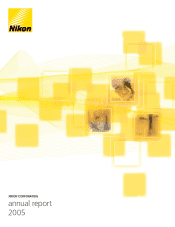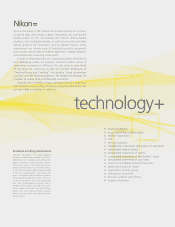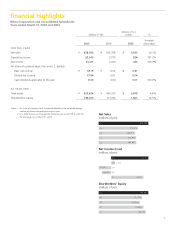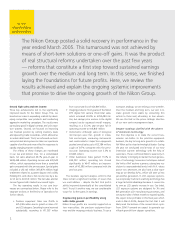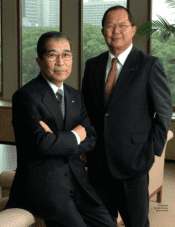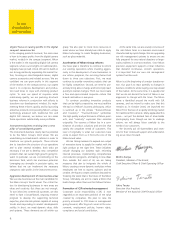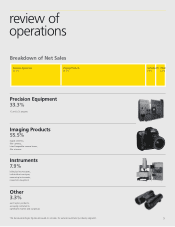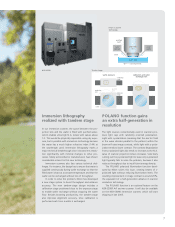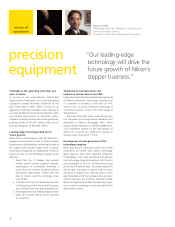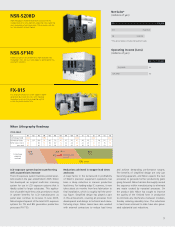Nikon 2005 Annual Report Download - page 9
Download and view the complete annual report
Please find page 9 of the 2005 Nikon annual report below. You can navigate through the pages in the report by either clicking on the pages listed below, or by using the keyword search tool below to find specific information within the annual report.
In our immersion scanner, the space between the pro-
jection lens and the wafer is fi lled with purifi ed water,
which enables ultra-high N.A. lenses with values above
1.0. This would be physically impossible using dry expo-
sure, but is possible with immersion technology because
the water has a much higher refractive index (1.44) at
the wavelength used. Immersion lithography marks a
major technical breakthrough since it boosts lens resolu-
tion signifi cantly with minimal changes to other pro-
cesses. Many semiconductor manufacturers have shown
considerable interest in this new technology.
Immersion scanners also face various technical chal-
lenges. For instance, the design has to ensure that water is
supplied continuously during wafer exchange so that the
fi lled water is kept at a constant temperature and that the
wafer can be exchanged without loss of throughput.
In order to solve this problem, Nikon has developed
a new stage system to boost throughput and enhance
accuracy. The new tandem-stage design includes a
calibration stage positioned close to the exposure stage
to enable wafer exchange without stopping the water
fl ow. Besides boosting productivity, the tandem stage
also improves alignment accuracy, since calibration is
performed each time a wafer is exchanged.
The light sources conventionally used in scanners pro-
duce light rays with randomly oriented polarization.
Light with s-polarization (meaning that the electric fi eld
in the wave vibrates parallel to the pattern) within the
beam will raise image contrast, while light with p-polar-
ization tends to lower contrast. The contrast degradation
from p-polarized light also tends to increase as the N.A.
value of scanner projection lenses increases. Selectively
cutting out the p-polarized light to leave only s-polarized
light typically fails to solve the problem, because it also
reduces throughput due to insuffi cient energy density.
The POLANO polarized illumination function devel-
oped by Nikon solves this issue, creating beams of s-
polarized light without reducing illumination levels. The
resulting improvement in image contrast is around 20%,
the equivalent of a half-generation advance in scanner
resolution technology.
The POLANO function is an optional feature on the
NSR-S308F ArF excimer scanner. It will also be available
on the NSR-S609B immersion scanner, which will start
shipping in late 2005.
POLANO function gains
an extra half-generation in
resolution
Immersion lithography
realized with tandem stage
Nikon’s Local Fill
Technology
Tandem Stage
NSR-S609B
7

